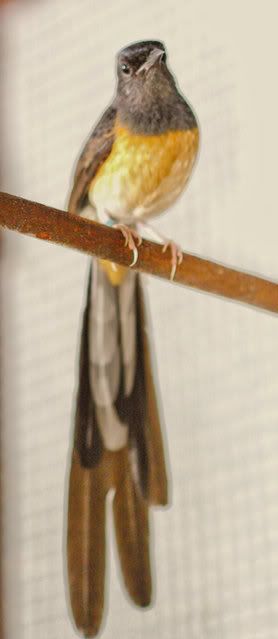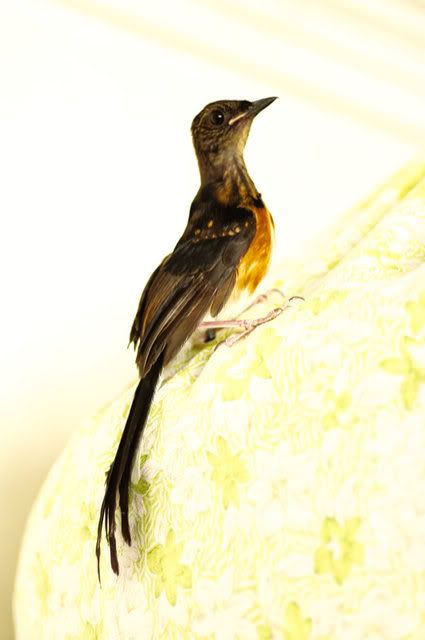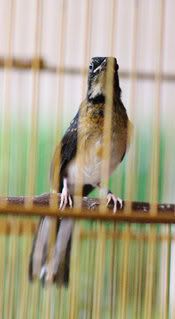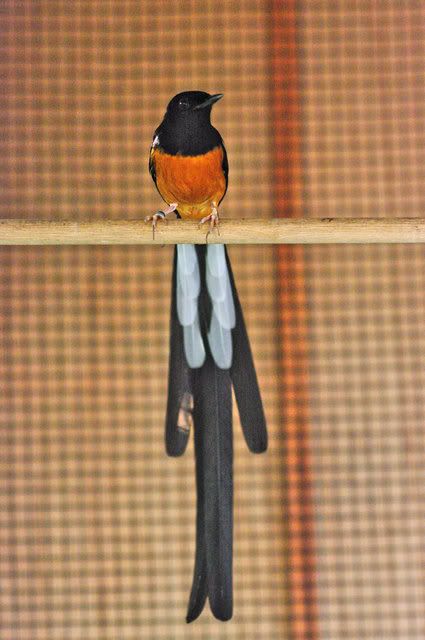My own experience over many years suggests that mature shamas in captivity that are provided with plentiful live food and a suitable environment, can raise 3 to 4 nests successfully each season. Captive shamas can raise more nests than those in the wild probably because they have a plentiful supply of live food and do not need to expend time and energy to hunt.
If the female is bred in her first year after she has completed her molt from juvenile, she will probably have only 1, or at the most, 2 nests. This is because a first year female will only be in breeding condition after she is more than 8 months of age and she can be expected to have a full or partial molt by the time she is a year old.
In my many years of shama breeding, I had not taken efforts to test the maximum number of nests that a pair can have under ideal conditions. This is because, I usually separate a pair after they have had 1 to 3 nests as I am not a commercial breeder and have no wish to be inundated with chicks.
Last year, I bred the pair of Icon and DDS139 for the first time. They had a total of 12 chicks from 4 nests of which 6 were male. The quality of the males ranged from very good to excellent with one of them, Longbow, being one of the best males I have ever bred.
I was curious to know how many chicks a pair can have under the conditions in which I breed shamas i.e. without any vitamin or mineral supplementation except for vitamin B. At the start of the breeding season this year, I decided to have a repeat mating of the exceptional pairing of Icon and DDS139 and to let them have as many nests as they can manage without detriment to their health or that of their offspring.
It would be most unsatisfactory to write about a Phenomenal Egg Laying Machine without showing readers a photograph of her. This is what she looks like today. I took the photo when she left the nest for a few minutes to stretch her muscles:

First Nest
The pair was placed in my indoor aviary at the end of April. The size of the aviary is 3’ x 5’ x 7'(H). On 16th April, the hen commenced sitting on 6 eggs. Five eggs hatched. The remaining egg was infertile. Because the hen had commenced sitting only when all the eggs were laid, the chicks hatched within a day and all were more or less the same size.
I should mention that this pair had also been bred in my indoor aviary last year and they were used to human traffic. They also did not mind if I occasionally checked the nest.
Only 2 of the 5 chicks from the first nest were male. Their bands were DDS206 and DDS207. DDS207 went to Jeffrey Low. This is DDS207:

DDS207 has very good structure and exceptional character. His drawback (if it can be regarded as a drawback) is that his primary tails are only about 5". My taimongs with short tails can be expected to have tails exceeding 10" after the first molt and more than 12" by the 3rd molt. For example, SuperModel's taimong tails were only 4 3/4" and he had tails exceeding 12" by the third molt.
The other male, DDS206 went to Taufik. This is what he looks like:

Jeffrey happened to choose first and his choice was DDS207. Justin and I would have chosen DDS206 as the chick that showed more potential. In fact, because DDS206 was my preference, I had given more care to him (by way of taking him out for car rides etc)than DDS207.
Jeffrey says that he chose DDS207 because he likes his posture and his aggressiveness and because there is something in him which Jeffrey's experience with shamas tells him will result in an exceptional bird. Jeffrey showed DDS207's aggressiveness recently, by placing an adult singing male on each side of him. Unlike most taimongs which would tend to keep still in such company, DDS207 displayed and sang his loud song.
DDS206 is also aggressive and, as I have mentioned, Justin and I would have chosen him. However, both chicks have their good points and it will be interesting to see how they turn out.
Anyway, I am happy that both Jeffrey and Taufik are happy with their chicks and I know that they are well able to care for and develop them to their full potential. Already these 2 chicks have attracted much favourable comment and I am glad that they went to my friends.
Second Nest
In the 2nd nest, the hen commenced sitting after laying 4 eggs but she did not sit at night so I suspected she would lay a fifth egg. She did and after doing so commenced to brood. I should mention that in the early days of brooding, the hen tends to emerge from the nest-box more often than towards the time of hatching. All the 5 eggs were fertile and 5 chicks hatched. Three of the chicks were large, 1 slightly smaller and 1 very small reflecting a difference of 2 days between the eldest chicks and the youngest.
I usually do not offer earthworms to my chicks but I did for those of the 2nd nest. On the evening of the 3rd day after hatching, I could hear the chicks calling to be fed when neither of the parents was at the box. This was a sure indication that the parents were not feeding the chicks or the chicks were not being fed enough. I removed the nest box and discovered that the chicks were suffering from diarrhoea. The cause was probably contaminated earthworms. I removed the chicks for hand-feeding. The youngest chick died 2 days later but the other 4 were fine by the end of May.
Third Nest
The third clutch of eggs was laid at the end of May. With this clutch, the female sat during the day from the laying of the third egg but emerged from the box and roosted alongside her mate until all the 5 eggs were laid when she commenced sitting in earnest. Four eggs hatched and the fifth egg was infertile.
DDS216 from the 3rd nest:

Fourth Nest
Towards the end of June, the female laid her 4th clutch of eggs. There were only 4 eggs in this clutch. Three hatched and the last egg was infertile. I was considering separating the pair as the number of eggs being laid seemed to be reducing. However, the hen started to mend her nest so I left the couple together.
Here is DDS225 from the 4th nest. He is 43 days old.

Fifth Nest
There were 5 eggs. Four hatched and 1 was infertile. Here are the 4 chicks together with 2 chicks from Max:
Sixth Nest
Today, 15th August, the hen commenced sitting on her 6th nest below:
The pair seem to still be in peak condition with no sign of molt.
From the 5 nests of chicks so far, I have banded 20 chicks for an average of 4 chicks per nest. About half of the chicks are male. I have parted with only 2 of the male chicks so far. I intend to keep the remaining chicks until after their first molt so that I can assess how they turn out.
Just as last year, all the offspring from Icon and his mate seem to have plenty of potential. None of them should be overlooked. Last year, I did not train the chicks and only separated them when they were about to molt. My friend Willima Kwa wanted one for his good friend. I caught one at random with a net for him from the third nest. The taimong tails were only 5.6" but it had 13" tails after the first molt. Longbow, from the same nest, had taimong tails that were shorter. After the first molt the tails were 11 1/4". It is now completing its 2 molt and the tails are already about 13" as shown in the photo taken below:

No comments:
Post a Comment